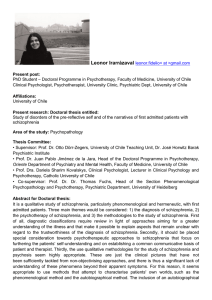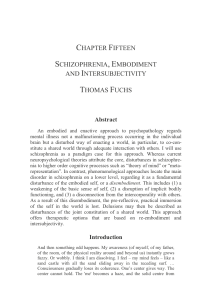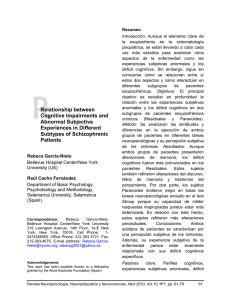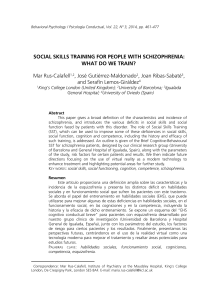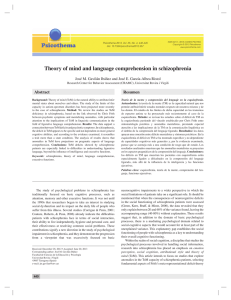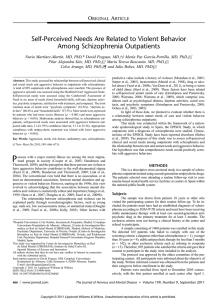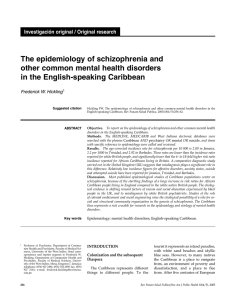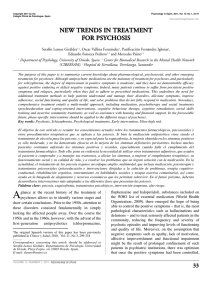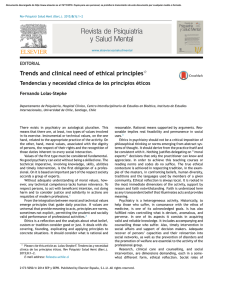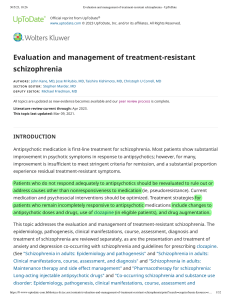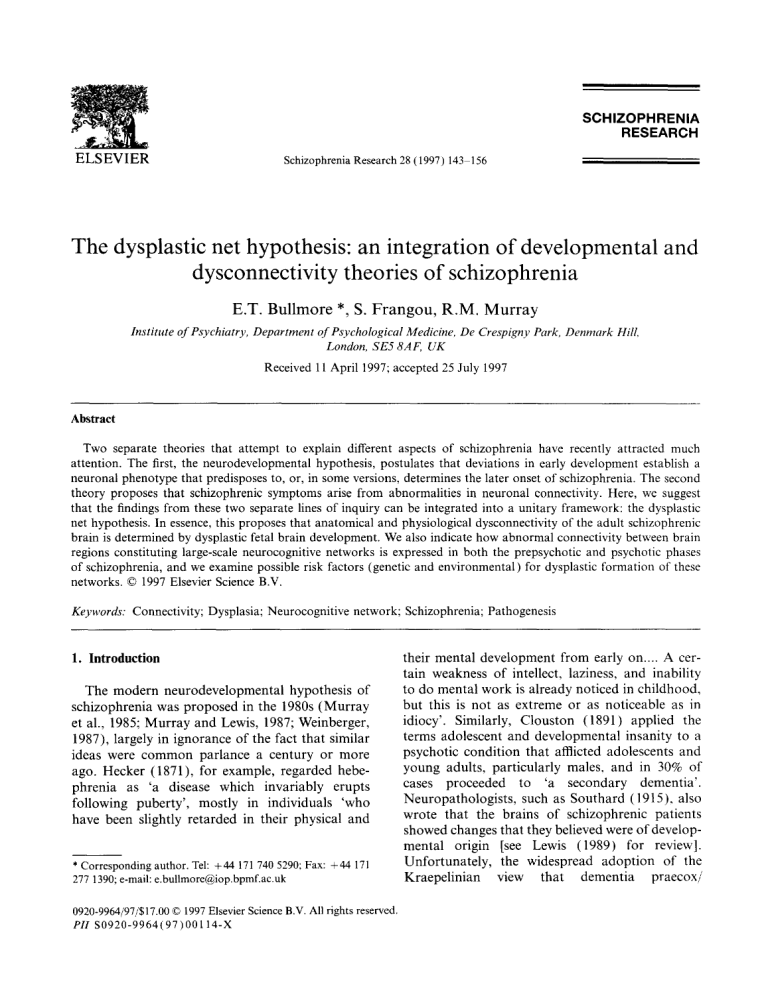
SCHIZOPHRENIA RESEARCH ELSEVIER Schizophrenia Research 28 (1997) 143 156 The dysplastic net hypothesis: an integration of developmental and dysconnectivity theories of schizophrenia E.T. Bullmore *, S. Frangou, R.M. Murray Institute of Psychiatry, Department of Psychological Medicine, De Crespigny Park, Denmark Hill, London, SE5 8AF, UK Received 1l April 1997; accepted 25 July 1997 Abstract Two separate theories that attempt to explain different aspects of schizophrenia have recently attracted much attention. The first, the neurodevelopmental hypothesis, postulates that deviations in early development establish a neuronal phenotype that predisposes to, or, in some versions, determines the later onset of schizophrenia. The second theory proposes that schizophrenic symptoms arise from abnormalities in neuronal connectivity. Here, we suggest that the findings from these two separate lines of inquiry can be integrated into a unitary framework: the dysplastic net hypothesis. In essence, this proposes that anatomical and physiological dysconnectivity of the adult schizophrenic brain is determined by dysplastic fetal brain development. We also indicate how abnormal connectivity between brain regions constituting large-scale neurocognitive networks is expressed in both the prepsychotic and psychotic phases of schizophrenia, and we examine possible risk factors (genetic and environmental) for dysplastic formation of these networks. © 1997 Elsevier Science B.V. Keywords: Connectivity; Dysplasia; Neurocognitive network; Schizophrenia; Pathogenesis 1. Introduction The modern neurodevelopmental hypothesis of schizophrenia was proposed in the 1980s (Murray et al., 1985; Murray and Lewis, 1987; Weinberger, 1987), largely in ignorance of the fact that similar ideas were c o m m o n parlance a century or more ago. Hecker (1871), for example, regarded hebephrenia as 'a disease which invariably erupts following puberty', mostly in individuals 'who have been slightly retarded in their physical and * Corresponding author. Tel: +44 171 740 5290; Fax: +44 171 277 1390; e-mail: [email protected] 0920-9964/97/$17.00 © 1997 Elsevier Science B.V. All rights reserved. PII S0920-9964(97)00114-X their mental development from early on .... A certain weakness of intellect, laziness, and inability to do mental work is already noticed in childhood, but this is not as extreme or as noticeable as in idiocy'. Similarly, Clouston (1891) applied the terms adolescent and developmental insanity to a psychotic condition that afflicted adolescents and young adults, particularly males, and in 30% of cases proceeded to 'a secondary dementia'. Neuropathologists, such as Southard (1915), also wrote that the brains of schizophrenic patients showed changes that they believed were of developmental origin [see Lewis (1989) for review]. Unfortunately, the widespread adoption of the Kraepelinian view that dementia praecox/ 144 E.T. Bullmore et al. / Schizophrenia Research 28 (1997) 143 156 schizophrenia was an adult-onset, progressive condition subsequently directed attention away from the pathogenic role of deviant development for three-quarters of a century. The revival of developmental theories of schizophrenia derived in part from epidemiological studies that confirmed the existence of early behavioral precursors of schizophrenia. These studies raised radical questions concerning the timing and type(s) of event(s) that might initiate the schizophrenic process. If schizophrenia does not begin when psychotic symptoms are first apparent, then when does it begin? The answer to this question must come from considering the brain abnormalities found in schizophrenia in the light of contemporary understanding of normal brain development. 2. When does the schizophrenic brain begin to become abnormal? Subtle structural brain abnormalities are frequently present in schizophrenia (Woodruff and Murray, 1994). Lateral ventricles, and, to a lesser extent, third and fourth ventricles, are enlarged from first presentation (Turner et al., 1986; DeLisi et al., 1992). Postmortem brains of schizophrenic patients are lighter by 5-8% and shorter by 4% (Brown et al., 1986; Bruton et al., 1990). Magnetic resonance imaging (MRI) studies have reported modest (about 5%), but significant, deficits in global gray matter volume (Zipursky et al., 1992; Harvey et al., 1993). Changes in neuronal density in cortical regions of schizophrenic patients have been described by Pakkenberg (1987) and Benes et al. (1991). Such findings are generally now interpreted as being developmental rather than degenerative in origin (Akbarian et al., 1993a,b; Murray, 1994), but at what point in the course of early brain development could aberration give rise to such anatomical abnormalities as are found in the brains of adult schizophrenics? Adverse events occurring during the first half of gestation cause syndromes of gross cortical malformation and resultant intellectual handicap. Since these are obviously different from the relatively subtle brain and behavioral changes found in schizophrenia (Woodruff and Murray, 1994), it is likely that the aberration(s) predisposing to schizophrenia occur(s) later in the course of normal brain development, possibly during the second half of gestation. 3. Dysplasia during the second half of gestation should result in abnormal asymmetry and connectivity of the adult brain During the second half of normal gestation, there is little increase in the number of neurons, but there are profound changes in neuronal organization and gross cerebral appearance. Afferent axonal projections from the thalamus and other regions of cortex invade the cortical plate and compete for synaptic territory. Macroscopically, the cerebral surface becomes convoluted, or gyrencephalic, and adult patterns of hemispheric asymmetry are established. The sylvian fissure appears asymmetrical from week 16 onwards, with the left (L) fissure typically being longer and straighter than its counterpart on the right (R); by week 31 asymmetry can be detected in the size of the planum temporale (L > R). The extent to which such lateralized patterns of cerebral organization are expressed during development is modulated by handedness (Kertesz et al., 1990) and by gender (McGlone, 1980), although the precise mechanisms involved are unknown. Geschwind and Galaburda (1985) have suggested that testicular development in the male fetus, leading to increased titers of testosterone, may exaggerate lateralized development in the male brain. Dysplasia during the second half of gestation should therefore produce an abnormal pattern of gender-modulated asymmetry in the adult brain. Microscopically, axonal projection and establishment of primary connections between neurons occur during this period. A primary connection between two (or more) neurons has a mutually trophic effect on their growth, perhaps mediated by compounds such as glutamate and cholecystokinin that have an established role as neurotransmitters in the adult brain (Kerwin and Murray, E.T. Bullmore et al. / Schizophrenia Research 28 (1997) 143-156 1992). Primary connection between neurones may also confer on them some protection against later regressive processes, such as cell death. On this basis, two further predictions can be made about the adult schizophrenic brain. First, major white matter tracts, formed by intra- and interhemispheric axonal projection, should be abnormal. Second, cortical regions that have not become connected in the normal manner may fail to benefit from the mutually trophic and protective effects of primary connectivity, leading to abnormally correlated growth of these regions, and ultimately to an abnormal pattern of correlations between regional gray matter volumes in adulthood. In short, impairment of brain development in the second half of gestation should result in (a) abnormal patterns of asymmetry, (b) abnormal axon tract formation, and (c) abnormal correlations between the volumes of various gray matter structures. Are the predicted abnormalities found in schizophrenia? 3.1. Brain asymmetry In the normal adult brain, the right hemisphere is typically more extensive than the left, anteriorly and superiorly; the left hemisphere is typically greater in extent than the right, posteriorly and inferiorly. The first imaging studies to consider the effect of schizophrenia on cerebral lateralization used computed tomography (CT) scans to measure right and left hemispheric width and/or length. Some reported reversal of the normal pattern in schizophrenic patients, but not all studies controlled for differences in gender and handedness, and the results were inconsistent (Tsai et al., 1983). Interest was revived by studies showing that temporal horn enlargement and reduction in temporal lobe volume were more marked on the left side than the right (Crow et al., 1989). Subsequently, in an MRI study, Bilder et al. (1994) combined multiple region-of-interest measurements in a summary descriptor of overall hemispheric asymmetry, or 'torque'. These investigators confirmed that regional volume asymmetries were affected by gender and handedness; after con- 145 trolling for these effects, schizophrenic patients had significantly reduced asymmetry in several brain regions, and were significantly more likely than controls to show reversed asymmetry (or torque) over all brain regions. Preliminary results from another study have also shown loss of torque in familial schizophrenic patients (Sharma et al., 1996). Similarly, Bullmore et al. (1995) used MR1 to measure radial displacement of the convoluted boundary between white and gray matter in both hemispheres and demonstrated reversed anterior hemispheric asymmetry specifically in schizophrenic males. More recently, studies using functional magnetic resonance imaging (fMRI) have demonstrated abnormal asymmetries in cerebral localization of receptive language functions. Woodruff et al. (in press) compared cerebral blood oxygenation changes induced in 15 male, right-handed schizophrenics and eight matched controls by periodic auditory-verbal stimulation (listening to a spoken narrative). Schizophrenics demonstrated significantly reduced left temporal cortical response to this stimulus, but significantly increased right temporal cortical response, compared with controls; i.e., a reversal of the normal 'left greater than right' pattern of response. 3.2. Corpus callosum The corpus callosum is the main white matter tract connecting the cerebral hemispheres, and incorporates at least 90% of all interhemispheric axonal projections. Woodruff et al. (1995) reviewed published MRI studies of the corpus callosum in schizophrenia. They noted the effects of gender and/or handedness on normal callosal anatomy and demonstrated, in a formal metaanalysis of 11 studies, a significant (4%) reduction in callosal area of schizophrenic patients, compared with controls. Lewis et al. (1988) had previously pointed out an association between psychosis and dysgenesis of the corpus callosum; this was subsequently confirmed by Swayze et al. (1990). Cavum septum pellucidum, which results from abnormal development of the corpus callosum, also occurs more frequently than expected in schizophrenia (Lewis 146 E.T. Bullmore et al. / Schizophrenia Research 28 (1997) 143 156 and Mezey, 1985; Degreef et al., 1992). Lewis et al. (1988) concluded that abnormal development of the corpus callosum may predispose to later schizophrenia. volumes in schizophrenic adults) that has motivated, and been supported by, multivariate analysis of structural MRI data by our group. 3.3. Abnormal correlations between regional cortical volume measurements A primary connection in utero between two neurons has a mutually trophic and protective effect on their subsequent development. Therefore, the growth of brain regions (e.g. prefrontal and superior temporal cortices) that are normally interconnected by dense and reciprocal axonal projection should be highly (positively) correlated; so we can predict that prefrontal and superior temporal cortical volumes will be highly (positively) correlated in a group of normal adults. Likewise, if normal connections fail to become established between these regions in utero, the growth of each region should be relatively independent of the other, and we can predict that correlation between adult regional brain volumes should be substantially reduced. We have recently tested this novel prediction of the dysplastic net hypothesis by correlational and multivariate analyses of multiple regional volume measurements on structural MRI data acquired from schizophrenics and controls (Bullmore et al., 1997). Schizophrenics were found to have significantly reduced positive correlation between several pairs of cortical regional volumes; the most salient differences relative to demographically matched controls were reductions in correlation (or statistical dependency) between left prefrontal and superior temporal cortices, and left prefrontal cortex and hippocampus (Woodruff et al., 1997). We conclude that the literature on schizophrenic brain anatomy includes several studies showing abnormal cerebral asymmetries and abnormal callosal structure, which are compatible with our hypothesis of a predisposing aberration in brain development during the second half of gestation. Furthermore, our hypothesis that the pathogenetically critical dysplastic event is a failure to establish a primary repertoire of axonal connections between spatially remote neurons generates a novel prediction (abnormally correlated regional brain 4. Can network models explain the features of schizophrenia? 'Higher order' mental processes, such as attention, language, and memory, cannot be localized to a single brain region. Instead, they are generally subserved by large-scale neurocognitive networks, comprising several spatially distributed, densely interconnected cortical regions (Mesulam, 1990). This neural architecture has the capacity to process information in parallel, which is computationally much more efficient and flexible than serial or hierarchical processing. The optimum functioning of such networks depends not only on the competence of their constituent cortical nodes but also on the integrity of axonal connections between nodes. For example, localized injury to axonal tracts linking intact Broca's and Wernicke's areas in the neurocognitive network for language causes the classic syndrome of linguistic dysfunction: conduction aphasia. 4.1. Cognitive deficits If, as we have hypothesized, axonal projection between cortical regions is compromised in preschizophrenic brain development, then we should expect impairment of those cognitive functions that depend on network integrity in the adult schizophrenic. Saykin et al. (1994) found evidence for cognitive deficits in first-episode, neurolepticnaYve schizophrenic patients. The functions most affected were verbal memory and learning, attention-vigilance, and visuomotor processing, all of which are likely to be subserved by spatially distributed cortical networks for parallel processing. This study adds to the growing evidence for persistent abnormalities of cognition, which Gold and Weinberger (1995) concluded are compatible with 'a compromise of integrative cortical function'. E. T. Bullmore et al. / Schizophrenia Research 28 (1997) 143-156 4.2. Negative signs Certain negative features of schizophrenia, such as poverty of speech, or alogia, may also be explicable in terms of impairment of network integrity. Frith et al. (1989) used positron emission tomography (PET) to study regional cerebral blood flow (rCBF) changes in normal subjects performing a verbal fluency (intrinsic word generation) task. They found increased rCBF in left dorsolateral prefrontal and parietal association cortices, left parahippocampal gyrus, and anterior cingulate gyrus; and decreased rCBF in bilateral temporal regions. Friston (1994) later used multivariate statistical techniques to compare this pattern of distributed activation with that seen in PET data from schizophrenic subjects performing an identical task. The pattern of strong inverse correlation between frontal and temporal rCBF changes found in normals was absent in schizophrenic patients. This finding was described as evidence for 'functional dysconnectivity' between frontal and temporal cortices in schizophrenics, and is clearly analogous to the reports, discussed above, of abnormal frontotemporal correlation or 'anatomical dysconnectivity' in schizophrenic structural imaging data. 4.3. Positive symptoms Dysconnectivity may thus underlie negative features of schizophrenia; but what of the positive symptoms? Psychologists have long theorized that auditory hallucinations may represent the sufferer's own inner speech, which is incorrectly perceived as coming from an external source (Frith, 1992). McGuire et al. (1993) tested this theory by examining rCBF in schizophrenic males, with singlephoton emission tomography (SPET), at the precise moment that they were experiencing auditory hallucinations, and then again in the non-hallucinating state. Auditory hallucinations were associated with increased blood flow in left temporofrontal regions, including Broca's area, the area normally concerned with linguistic output. McGuire et al. (1995) went on to study schizophrenic patients with a history of frequent auditory hallucinations while they imagined hearing senten- 147 ces as if spoken to them by another person. Performance of this task was associated with significant rCBF changes in a cortical network including left inferior frontal and middle temporal gyri, and the supplementary motor area (SMA). Normal controls showed significant activation in all three areas, whereas the schizophrenic patients showed significant deactivation in the middle temporal gyrus and SMA. In other words, individuals with a liability to auditory hallucinations had disintegrated activation of a network comprising frontal and temporal lobe regions, which may normally be responsible for monitoring and labeling (as self or other) internal speech. Further evidence of a disruption of normal frontotemporal connectivity comes from a study of monozygotic twins discordant for schizophrenia, in which the affected twins had a smaller left hippocampal volume than the unaffected twins. This volume reduction was negatively correlated with activation of prefrontal cortex, measured by rCBF during the Wisconsin card sorting test. This suggested to Weinberger et al. (1992) that 'schizophrenia involves pathology of... a widely distributed neocortical-limbic neural network'. Hoffman and McGlashan (1993) have provided a theoretical framework for such theories by using computer models of neurocognitive networks in the brain to examine the effects on network function of reduced connectivity between nodes. They found that as connectivity was reduced, their model network became functionally fragmented and parts of it showed autonomous or 'parasitic' behavior, which they considered analogous to the emergence of passivity phenomena or auditory hallucinations from similarly disconnected networks in the schizophrenic brain. Thus, the cognitive, negative, and positive features of schizophrenia can be conceptualized as the functional expression of abnormal connections between cortical regions constituting neurocognitire networks. The dysplastic net hypothesis postulates that such abnormal neural network connectivity is determined by dysplastic, gendermodulated axonal projection and/or synapse formation in the second half of fetal life. Two further predictions of this hypothesis are: (1) that impairment of those cognitive functions 148 E. 72 Bullmore et al. / Schizophrenia Research 28 (1997) 143-156 dependent on network integrity is expected not only in schizophrenic adults but also in preschizophrenic children (that is, children who will later become schizophrenic); and (2) that there will be differences between male and female schizophrenics due to the modulating effects of gender on fetal brain development. with non-psychotic attendees. The greatest difference between these groups was the more frequent occurrence of language and speech difficulties in the preschizophrenic patients; disordered language was most evident among those who became psychotic before age 14 years. 5.2. Cohort studies 5. Are the characteristics of preschizophrenic children compatible with dysplastic neurocognitive network formation? 5.1. Retrospective andJollow-back studies There is considerable evidence for cognitive dysfunction in preschizophrenic children. Foerster et al. (1991) obtained retrospective maternal reports on 115 schizophrenic and 67 affective psychotic patients; low educational achievement was more common among the former. In an extension of this study, Jones et al. (1994a) found that the schizophrenic patients had shown poorer scholastic performance and scored lower on measures of intelligence. Jones et al. (1994a) also studied schizophrenic adults who had previously attended the Maudsley Hospital Children's Department. Lower IQ scores were found in the childhood records of the 50 attendees who later developed schizophrenia (mean IQ=85), compared with a control group of 45 who subsequently developed affective disorder. Russell et al. (1997) subsequently compared the childhood IQ scores of 34 of the subjects at the time that they had attended the child psychiatry department with their scores 20 years later after they had developed schizophrenia. The scores were very similar, implying that cognitive dysfunction is a stable characteristic of schizophrenic patients in both the pre- and post-psychotic phases. In particular, cognitive dysfunction is reported in those preschizophrenic patients who go on to develop psychosis in adolescence, a finding that suggests that developmental dysplasia may be especially relevant to early-onset schizophrenia. For example, Hollis (1995) compared 61 children and adolescents with schizophrenia who had attended the Maudsley child psychiatric services Two large cohort studies indicate that low IQ is a risk factor for subsequent schizophrenia. This was noted by David et al. (1995), who obtained IQ scores at age 18 years on inductees to the Swedish Army and then followed up the subjects. Similarly, in the British birth cohort studied by Jones et al. (1994b), the 30 preschizophrenic patients had lower verbal and non-verbal IQ scores at age 8 years than the remaining 4716 subjects. The preschizophrenics were almost five times more likely than controls to be without speech at age 2years than the controls. The fact that speech difficulties are a risk factor for later schizophrenia is not surprising, given the evidence reviewed above that positive and negative symptoms and signs are secondary to dysconnected language systems. 5.3. High-risk studies Having established the existence of cognitive abnormalities in preschizophrenic children, it is pertinent to ask if these abnormalities are genetically determined. Since having an affected family member remains the strongest risk factor for schizophrenia (Gottesman, 1991), an obvious approach is to study the offspring of schizophrenic patients. Fish (1977) described an abnormal sequence of cognitive development in seven offspring of schizophrenic mothers who went on to develop schizophrenia, and concluded that the schizophrenic genotype manifests in infants as a heritable neurointegrative defect, which she termed pandysmaturation. Marcus et al. (1993) compared the development of school-age children born of schizophrenic parents with that of children of healthy parents or parents with other psychiatric disorders. The offspring of schizophrenic patients were more E.T. Bullmore et al. / Schizophrenia Research 28 (1997) 143-156 likely to show perceptual-cognitive and motoric dysfunction. These findings support the idea that certain neurointegrative deficits reflect genetic risk of schizophrenia and that these deficits are clearly apparent in infancy, and at school age, long before the onset of psychosis. Cannon et al. (1997) have recently confirmed this in a large cohort study by showing not only that preschizophrenic children had lower IQ than controls but also that their nonpsychotic siblings had IQ scores between those of the schizophrenics and the controls. The lower IQ of the preschizophrenic children, compared with their siblings, was explained by a higher prevalence of obstetric complications in the former (vide infra). 6. Are the gender differences found in schizophrenia and in late fetal brain development compatible? Males have an earlier age of onset of schizophrenia (Lewine, 1988; Castle et al., 1993), have more negative symptoms, and have a worse outcome (Castle and Murray, 1991; Van Os et al., 1995). Schizophrenic males also exhibit more abnormalities of childhood personality and social adjustment than their female counterparts (Foerster et al., 1991 ). Low IQ, poor school performance, and increased 'soft' neurological signs are noted more frequently in males than females who later developed schizophrenia (Jones et al., 1994a). The above gender differences have been related to evidence that ventricular enlargement appears more pronounced in male than female schizophrenic patients (Woodruff and Murray, 1994; Lewine et al., 1995). Indeed, ventricular enlargement appears to be particularly marked in male non-familial cases. Six studies have shown that male non-familial patients have larger ventricles than their familial counterparts; no such familial/non-familial difference has been found for females (Murray and Jones, 1996; O'Connell et al., 1997). The obvious implication is that some environmental effect is operating particularly on male schizophrenics without a family history. Since male neonates are more prone to develop lasting neurodevelopmental damage following 149 obstetric adversity, several investigators have suggested that pregnancy and birth complications (PBCs) may be the critical early environmental effect (Cantor-Graae et al., 1994; McGrath and Murray, 1995). This line of reasoning suggests that the increased frequency (or pathogenicity) of obstetric complications in the histories of male rather than female schizophrenic patients may contribute to the greater severity of premorbid abnormalities in male than in female preschizophrenics, and the earlier onset of schizophrenia in males. Thus, Rifkin et al. (1994) found that in male (but not female) schizophrenic patients, a low birth weight was correlated with poor premorbid function and cognitive ability. Furthermore, Kirov et al. (1996) have shown, in a series of 73 white schizophrenic patients, that when one removes those who have suffered obstetric complications (predominantly male), the gender difference in age of onset disappears. In summary, it is clear that the manifestations of schizophrenia are indeed modified by gender. These different characteristics are already detectable in childhood and may reflect sex-modulated vulnerability to environmental effects operating during the second half of gestation. 7. Is dysplastic development of neurocognitive networks in schizophrenia genetically determined? There is, of course, long-standing evidence of a genetic contribution to schizophrenia (Kendler and Diehl, 1993), evidence that has been reconfirmed in large and sophisticated family (Kendler et al., 1993) and adoption (Kety et al., 1994) studies. If schizophrenia results from dysplastic formation of neurocognitive networks, then one should seek mutations in genes that control the development and interconnections of neurons (Jones and Murray, 1991). One intriguing possibility in this respect is that genes controlling expression of neurotrophic factors, such as glutamate, might provide a molecular mechanism for the failure of schizophrenics to establish secure, mutually trophic primary connections between brain regions (Kerwin and Murray, 1992). Abnormalities in glutamate concentration and 150 E. 1~ Bullmore et al. / Schizophrenia Research 28 (1997) 143-156 receptor binding are well documented in postmortem studies of adult schizophrenic brains (Deakin et al., 1989; Kerwin et al., 1990). However, it still remains to be established incontrovertibly that the structural brain changes found in schizophrenia are genetically determined, whatever the identity of the putative gene(s). Cannon et al. (1993) compared CT brain scans of individuals with one or two parents affected with schizophrenia with those of the offspring of normal parents. They found a generalized effect of genetic risk for schizophrenia on brain structures regardless of region, and a linear increase in the CSF-brain ratios with an increasing level of genetic risk. The unaffected siblings of schizophrenics have been reported to have larger ventricles than unrelated normal controls (Weinberger et al., 1981; DeLisi et al., 1986). Also, in families multiply affected with schizophrenia, where genetic factors can be assumed to predominate, CT and MRI studies have demonstrated increased ventricular volume in both the affected members and some of their well relatives (Honer et al., 1994; Sharma et al., in press). Do the brain abnormalities in such genetically loaded families result from dysplasia in the second half of gestation? If so, one would expect loss of normal brain asymmetry to be particularly evident in familial schizophrenic patients. Sharma et al. (1996) examined this issue in a sample of schizophrenic patients and their unaffected first-degree relatives from multiply affected families. Compared with controls, the normal pattern of frontal and occipital asymmetry was lost in the schizophrenic patients and in those relatives who, from the patterns of illness in the families, appeared to have transmitted the schizophrenic genotype without being clinically affected themselves. These findings are compatible with the suggestion of Crow et al. (1989) that loss of normal brain asymmetry in schizophrenia reflects disturbances in the expression of the gene(s) that control(s) the development of brain asymmetry. Furthermore, they obviously point to the period of the development of normal asymmetry as the critical period for the expression of susceptibility gene(s). 8. Is dysplastic development of neurocognitive networks in schizophrenia environmentally determined? Imaging studies of monozygotic (MZ) twins discordant for schizophrenia have shown ventricular enlargement and reduction in volume of the temporal lobe and anterior hippocampus in the schizophrenic twin, compared with his or her unaffected cotwin (Reveley et al., 1984; Suddath et al., 1990). Since MZ twins share all their genes, this argues for either an environmental effect alone or an environmental effect operating on predisposing genes. Thus, any interpretation of the neuroanatomical findings in schizophrenia must take into account the contribution of environmental factors. What are these, and does their timing support our thesis that a critical aberration in development of corticocortical connectivity occurs in the second half of gestation? Four reviews have summarized the literature on pregnancy and birth complications (PBCs) and schizophrenia. McNeil (1995) concluded that seven out of eight studies that examined obstetric records and nine out of 13 studies that relied on maternal recall found schizophrenic patients to have an excess of PBCs. Goodman (1988) calculated that PBCs increase an individual's lifetime risk of schizophrenia from 0.6% to about 1.5%, while a meta-analysis carried out by Geddes and Lawrie (1995) also suggested that PBCs doubled the risk. A final review by McGrath and Murray (1995) pointed out the deficiencies in three recent negative studies (Done et al., 1991; McCreadie et al., 1992; Buka et al., 1993). Some studies suggest that schizophrenic patients have lower birth weights than their unaffected siblings (Lane and Albee, 1966; Woerner et al., 1973) and have a lower mean birth weight than normal controls (Rifkin et al., 1994). Moreover, three recent studies have shown that preschizophrenic patients have a smaller head circumference at birth even when gestational age is taken into account (McNeil et al., 1993; Kunugi et al., 1996; Hultman et al., 1997). Since head circumference at birth is largely determined by intrauterine brain growth, this presumably reflects some earlier impairment of normal brain development. E. 72 Bullmore et al. / Schizophrenia Research 28 (1997) 143-156 Whether earlier impairment of brain development causes the excess of perinatal complications observed in schizophrenia remains an open question (Goodman, 1988). Certainly, a preexisting neural tube defect can be the cause of perinatal complications (Nelson and Ellenberg, 1986). Wright et al. (1995) reported that those preschizophrenic patients whose mothers had influenza during the second trimester of gestation were of lower birth weight and subject to more perinatal difficulties than schizophrenic patients whose mothers had no infections during pregnancy. Could at least some of the excess of PBCs in schizophrenic patients be secondary to exposure to maternal infection? The relationship of prenatal exposure to influenza epidemics to later schizophrenia has attracted much recent attention. The majority of studies (Mednick et al., 1988; Barr et al., 1990; O'Callaghan et al., 1991; McGrath et al., 1995), but not all (Crow and Done, 1992; Susser et al., 1994) have shown that those born following epidemics of influenza have an increased risk of schizophrenia. The peak risk for schizophrenia following exposure to influenza appears to be between the fifth and seventh month of gestation (Sham et al., 1992; Adams et al., 1993; Stober et al., 1994; Takei et al., 1994). Furthermore, Takei et al. (1996) have reported that those schizophrenic patients exposed to a high prevalence of influenza during the fifth month of gestation show a greater degree of sylvian fissure widening than those whose mid-gestation occurred during relatively influenzafree periods. This preliminary finding provides direct empirical support for the notion that adult brain abnormalities in schizophrenia may be causally related to developmentally adverse events in the second half of pregnancy. Studies have also examined the relationship between PBCs and adult brain structure in schizophrenia (reviewed by McGrath and Murray, 1995); but unfortunately, most have had to rely on maternal recall for the obstetric information. One exception is the study of Cannon et al. (1993), which showed that in individuals at high genetic risk for schizophrenia, PBCs predicted increased ventricular size. Recently, Stefanis et al. (submitted) compared hippocampal volume in 21 schizophrenics 151 who had suffered no PBCs but came from multiply affected families with that of normal controls; no differences were found. However, 26 schizophrenics who had no affected relatives but who had suffered severe PBCs showed significantly reduced left hippocampal volume, compared with the controls. Since the hippocampus is highly susceptible to hypoxia, this study implies that the reduction in hippocampal volume generally reported in schizophrenia may be consequent, not on aberrant genes, but rather on a sequel of perinatal hypoxic-ischemic damage. This finding is particularly interesting because reduced left hippocampal volume is a common (but not universal) finding in schizophrenia. Furthermore, Rushe (1996) noted that while normal subjects showed a correlation between left hippocampal volume and performance on tests of verbal memory, this correlation is lost in male schizophrenics; furthermore, the schizophrenics showed an increased correlation between right hippocampal volume and visual recall memory and visuospatial learning. This pattern of apparent switch of some neuropsychological functions from the left to right hippocampus in schizophrenia is reminiscent of the finding of Woodruff et al. (in press), discussed earlier, that schizophrenics appear to have switched auditory processing from the left to the right temporal cortex. To learn more about the adult sequelae of early hypoxic-ischemic damage, we have begun a study of adults born prematurely. Numerous prospective studies of low-birth-weight and premature babies have shown that they have an increased risk of neuromotor, cognitive, and behavioral disorder during childhood (Roth et al., 1993). Premature babies are particularly susceptible to hypoxic-ischemic damage, and intraventricular and periventricular hemorrhage is a common consequence, often with secondary ventricular dilatation. The latter can be detected on cranial ultrasound at birth, and predicts poor psychomotor and neuropsychiatric outcome at 8 years of age (Roth et al., 1993, 1994). We have preliminary results from an imaging study of cerebral structure at age 14years in individuals who were born at less than 33 weeks. Radiologists blindly rated over two-thirds of their MRI scans as abnormal, compared with only 7% 152 E. T. Bullmore et al. / Schizophrenia Research 28 (1997) 143-156 of normal gestation control individuals. Abnormal thinning of the corpus callosum, ventricular enlargement, and periventricular abnormalities were particularly common. Thus, it is clear that events before or during birth can mimic some of the cerebral structural abnormalities (e.g. abnormalities of the corpus callosum) that are found in schizophrenia and that, we suspect, are consequent upon developmental events in the second half of gestation. Nevertheless, most fetuses exposed to a broad range of PBCs do not develop schizophrenia, and most patients with schizophrenia have no history of obvious PBCs. One possibility, congruent with the dysplastic net hypothesis, is that PBCs increase the risk of later schizophrenia only when certain critical neuronal circuits are compromised. Persaud et al. (unpublished results) have shown that schizophrenic patients have more whitematter hyperintensities than bipolar patients and controls; these were positively associated with a history of PBCs. Neonatal pediatricians report similar perivascular lesions following hypoxic-ischemic damage. One might speculate that such white matter lesions would be particularly likely to lead to dysconnectivity of neurocognitive network. Thus, developmental epidemiology suggests that pre- and perinatal complications, including exposure to prenatal viral infection in the second half of gestation, and hypoxic-ischemic damage, are risk factors for schizophrenia, while some neuroimaging studies indicate that early exposure to such developmentally adverse events may induce adult brain abnormalities similar to those seen in schizophrenia. 9. Conclusions Bleuler's word schizophrenia, by definition, implies a mental condition characterized by schism, disintegration, or dysconnectivity. As he put it: The thousands of associations guiding our thought are interrupted by this disease in an irregular way here and there, sometimes more, sometimes less. The thought processes, as a result, become strange and illogical, and the associations find new paths. (E. Bleuler, 1911, p. 14). Much of the evidence reviewed above, especially from structural and functional neuroimaging studies, suggests that there may be a biological analog to this long established psychological observation. In other words, anatomical and physiological connections between brain regions, as well as associations between ideas, may be irregularly interrupted in schizophrenia. The case has not yet been proved decisively, perhaps partly because many neuropathological and imaging studies of schizophrenia have adopted a 'region of interest' methodology, which implicitly assumes there is a focal brain lesion. In contrast, dysconnectivity models of schizophrenia assume that the neural pathology is distributed. We anticipate that in the future, more neurobiological studies of schizophrenia will adopt statistical methods (e.g. multivariate analyses) better suited to exploration of distributed or dysconnected pathology (Friston, 1994; Bullmore et al., 1997). However, the question at the heart of this paper is whether dysconnectivity in schizophrenic patients can be explained by dysplastic brain development in utero. We have argued that the neurodevelopmental processes most likely to determine adult patterns of corticocortical connectivity occur in the second half of normal gestation, for it is at this stage of pregnancy that exuberant axonal projections first invade the cortical plate and compete for synaptic territory. It is also during the second half of pregnancy that gender-modulated patterns of cerebral asymmetry become macroscopically evident. If brain development is indeed disordered at this stage in pregnancy, one would therefore expect to find abnormal patterns of cerebral asymmetry in schizophrenic adults, a modulating effect of gender on abnormal brain structure and function, and psychological deficits compatible with impaired neurocognitive network function in childhood. All of these expectations have been reviewed, and largely upheld, in the light of the existing literature. Furthermore, we have shown that the dysplastic net hypothesis can generate a novel prediction about adult brain structure in schizophrenia (abnormally correlated or 'anatomically dysconnected' regional brain volumes) that has been empirically supported by appropriate E.T. Bullmore et al. / Schizophrenia Research 28 (1997) 143-156 analyses of structural MRI data (Woodruff et al., 1997). Of course, many questions remain. We conclude with a few that seem particularly pertinent. What is the molecular mechanism for the proposed failure of neurocognitive network nodes to establish normal connections in utero? In particular, how relevant are abnormalities in glutamate metabolism? Could the same molecular mechanism for dysplastic net formation act as a 'final common pathway' by which genetic and/or early environmental pathogens predispose to corticocortical dysconnectivity in adulthood? Can the model be validated by study of adult brain structure and function in nonhuman primates known to have suffered a specific developmental insult during the second half of gestation, or by a study of human adults born prematurely and therefore likely to have suffered significant late gestational adversity? How anatomically and functionally specific is dysconnectivity in adult schizophrenics? Is it, for example, limited to frontal and temporal systems specialized for language? Is there any prophylactic or therapeutic advantage to be gained by thinking about the cerebral correlates of schizophrenia in this way? Acknowledgment ETB is supported by the Wellcome Trust. References Adams, W., Kendell, R.E., Hare, E.H., Munk-Jorgensen, P., 1993. Epidemiological evidence that maternal influenza contributes to the aetiology of schizophrenia. An analysis of Scottish, English, and Danish data. Br. J. Psychiatry 163, 522-534. Akbarian, S., Bunney, W.E., Potkin, S.G., Wigal, S.B., Hagman, J.O., Sandman, C.A., Jones, E.G., 1993a. Altered distribution of nicotinamide-adenosine dinucleotide phosphate-diaphorase cells in frontal lobe of schizophrenics implies disturbances of cortical development. Arch. Gen. Psychiatry 50, 169 177. Akbarian, S., Vinuela, A., Kim, J.J., Potkin, S.G., Bunney, W.E., Jones, E.G., 1993b. Distorted distribution of nicotinamide-adenosine dinucleotide phosphate-diaphorase neu- 153 rones in temporal lobe of schizophrenics implies anomalous cortical development. Arch. Gen. Psychiatry 50, 178 187. Barr, C.E., Mednick, S.A., Munk-Jorgensen, P., 1990. Exposure to influenza epidemics during gestation and adult schizophrenia. A 40-year study. Arch. Gen. Psychiatry 47, 869-874. Benes, F.M., McSparren, J., Bird, E.D., San Giovanni, J.P., Vincent, S.L., 1991. Deficits in small interneurons in prefrontal and cingulate cortices of schizophrenic and schizoaffective patients. Arch. Gen. Psychiatry 48, 996-1001. Bilder, R.M., Wu, H., Bogerts, B., Degreef, G., Ashtari, M., Alvir, J.M.J., Snyder, P.J., Lieberman, J.A., 1994. Absence of regional hemispheric volume asymmetries in first episode schizophrenia. Am. J. Psychiatry 151, 1437-1447. Bleuler, E., 1911. Dementia Praecox or the Group of Schizophrenias (trans. 1950, J. Zimkins). George Allen & Unwin, London. Brown, R., Colter, N., Corsellis, J.A.N., Crow, T.J., Frith, C.D., Jargoes, R., Johnstone, E.C., Marsh, L., 1986. Postmortem evidence of structural brain changes in schizophrenia: differences in brain weight, temporal horn area, and parahippocampal gyrus compared with affective disorder. Arch. Gen. Psychiatry 43, 36-42. Bruton, C.J., Crow, T.J., Frith, C.D., Johnstone, E.C., Owens, D.G.C., Roberts, G.W., 1990. Schizophrenia and the brain: a prospective clinico-neuropathological study. Psychol. Med. 20, 285-304. Buka, S.L., Tsuang, M.T., Lipsitt, L.P., 1993. Pregnancy," delivery complications and psychiatric diagnosis. A prospective study. Arch. Gen. Psychiatry 50, 151-156. Bullmore, E.T., Brammer, M.J., Harvey, I., Murray, R., Ron, M., 1995. Cerebral hemispheric asymmetry revisited: effects of gender, handedness and schizophrenia measured by radius of gyration in magnetic resonance images. Psychol. Med. 25, 349 363. Bullmore, E.T., Woodruff, P.W.R., Wright, I.C., Rabe-Hesketh, S., Howard, R.J., Shuriquie, N., Murray, R.M., 1997. Does dysplasia cause anatomical dysconnectivity in schizophrenia? Schizophr. Res. in press. Cannon, T.D., Mednick, S.A., Parnas, J., Schuksinger, F., Preastholm, J., Vestergaad, A., 1993. Developmental brain abnormalities in the offspring of schizophrenic mothers. Arch. Gen. Psychiatry 47, 622 632. Cannon, T.D., Beardon, C.E., Hollister, M., Hadley, T., 1997. A prospective cohort study of childhood dognitive deficits as precursors of schizophrenia. Schizophr. Res. 24, 99 Cantor-Graae, E., McNeil, T.F., Nordstrom, L.G., Rosenlund, T., 1994. Obstetric complications and their relationship to other etiological risk factors in schizophrenia. A case control study. J. Nerv. Ment. Dis. 182, 645 650. Castle, D.J., Murray, R.M., 1991. The neurodevelopmental basis of sex differences in schizophrenia. Psychol. Med. 21, 565-575. Castle, D.J., Wessely, S., Murray, R.M., 1993. Sex and schizophrenia: effects of diagnostic stringency, and associations with premorbid variables. Br. J. Psychiatry 162, 658-664. Clouston, T.S., 1891. The Neuroses of Development. Oliver and Boyd, Edinburgh. 154 E.T. Bullmore et al. / Schizophrenia Research 28 (1997) 143 156 Crow, T.J., Ball, J., Bloom, S.R., Brown, R., Bruton, C.J., Colter, N., Frith, C.D., Johnstone, E.C., Owens, D.G., Roberts, G.W., 1989. Schizophrenia as an anomaly of cerebral asymmetry. A post-mortem study and a proposal concerning the genetic basis of the disease. Arch. Gen. Psychiatry 46, 1145-1150. Crow, T.J., Done, D.J., 1992. Prenatal exposure to influenza does not cause schizophrenia. Br. J. Psychiatry 161,390-393. David, A.S., Malmberg, A., Lewis, G., Brandt, L., Allebeck, P., 1995. Premorbid psychological performance as a risk factor for schizophrenia. Schizophr. Res. 15, 114 Deakin, J.F.W., Slater, P., Simpson, M.D.C., Guilchrist, A.C., Skan, W.J., Royston, W.J., Reynolds, G.P., Cross, A.J., 1989. Frontal cortical and left temporal glutamatergic dysfunction in schizophrenia. J. Neurochem. 52, 1781 1786. Degreef, G., Bogerts, B., Falkai, P., Greve, B., Lantos, G., Ashtari, M., Lieberman, J., 1992. Increased prevalence of cavum septum pellucidum in magnetic resonance scans and post-mortem brains of schizophrenic patients. Psychiatry Res. 45, 1-13. DeLisi, L.E., Goldin, L.R., Hamovit, J.R., Maxwell, M.E., Kurtz, D., Gershon, E.S., 1986. A family study of the association of increased ventricular size with schizophrenia. Arch. Gen. Psychiatry 43, 148-153. DeLisi, L.E., Strizke, P., Riordan, H., Holan, V., Boccio, A., Kushner, M., McClelland, J., Van Eylo, O., Anand, A., 1992. The timing of brain morphological changes in schizophrenia and their relationship to clinical outcome. Biol. Psychiatry 31,241-254. Done, D.J., Johnstone, E.C., Frith, C.D., Golding, J., Shepherd, P.M., Crow, T.J., 1991. Complications of pregnancy and delivery in relation to psychosis in adult life. Br. Med. J. 302, 1576-1580. Fish, B., 1977. Neurobiologic antecedents of schizophrenia in children. Arch. Gen. Psychiatry 34, 1297-1313. Foerster, A., Lewis, S.W., Owen, M.J., Murray, R.M., 1991. Premorbid personality and psychosis: effects of sex diagnosis. Br. J. Psychiatry 158, 171-176. Friston, K.J., 1994. Functional and effective connectivity in neuroimaging: a synthesis. Hum. Brain Mapping 2, 56-78. Frith, C.D., 1992. The Cognitive Neuropsychology of Schizophrenia. Lawrence Erlbaum, Hove, UK. Frith, C.D., Friston, K.J., Liddle, P.F., Frackowiak, R.S.J., 1989. A PET study of word finding. Neuropsychologia 28, 1137 1148. Geddes, J.R., Lawrie, S.M., 1995. Obstetric complications and schizophrenia: a metanalysis. Br. J. Psychiatry 167, 786-793. Geschwind, N., Galaburda, A.M., 1985. Cerebral lateralisation. Biological mechanisms, associations, and pathology. Arch. Neurol. 42, 428459. Gold, J.M., Weinberger, D.R., 1995. Cognitive deficits and the neurobiology of schizophrenia. Curr. Opin. Neurobiol. 5, 225-230. Goodman, R., 1988. Are complications of pregnancy and birth causes of schizophrenia? Dev. Med. Child Neurol. 30, 391 395. Gottesman, I.I., 1991. Schizophrenia Genesis: The Origins of Madness. W.H. Freeman, New York. Harvey, I., Ron, M.A., Du Boulay, G., Wicks, D., Lewis, S.A., Murray, R.M., 1993. Reduction in cortical volume in schizophrenia on magnetic resonance imaging. Psychol. Med. 23, 591-604. Hecker, E., 1871. Die Hebephrenie. Virchows Archiv. [A] 52, 394-429. Hoffman, R.R., McGlashan, T.H., 1993. Parallel distributed processing and the emergence of schizophrenic symptoms. Schizophr. Bull. 19, 257 261. Hollis, C., 1995. Child and adolescent (juvenile onset) schizophrenia. A case control study of premorbid developmental impairments. Br. J. Psychiatry 166, 489-495. Honer, W.G., Bassett, A.S., Smith, G.N., Lapointe, J.S., Falkai, P., 1994. Temporal lobe abnormalities in multigenerational families with schizophrenia. Biol. Psychiatry 36, 737 743. Hultman, C.M., Ohman, A., Cnattingius, S., Wieselgren, L.M., Lindstrom, L.H., 1997. Prenatal and neonatal risk factors for schizophrenia. Br. J. Psychiatry 170, 128-133. Jones, P., Guth, C , Lewis, S., Murray, R., 1994a. In: David, A., Cutting, J. (Eds.), The Neuropsychology of Schizophrenia. Lawrence Erlbaum, Hove, UK, pp. 131-144. Jones, P.B., Murray, R.M., 1991. The genetics of schizophrenia is the genetics of neurodevelopment. Br. J. Psychiatry 158, 615-623. Jones, P., Rodgers, B., Murray, R., Marmot, M., 1994b. Child developmental risk factors for adult schizophrenia in the British 1946 birth cohort. Lancet 344, 1398-1402. Kendler, K.S., Diehl, S.R., 1993. The genetics of schizophrenia: a current, genetic epidemiologic perspective. Schizophr. Bull. 19, 261 285. Kendler, K.S., McGuire, M., Gruenberg, A.M., O'Hare, A., Spellman, M., Walsh, D., 1993. The Roscommon Family Study. I. Methods, diagnosis of probands, and risk of schizophrenia in relatives. Arch. Gen. Psychiatry 50, 527 540. Kertesz, A., Polk, M., Black, S.E., Howell, J., 1990. Sex, handedness, and the morphometry of cerebral assymetries on magnetic resonance imaging. Brain Res. 530, 40-48. Kerwin, R., Murray, R.M., 1992. A developmental perspective on the pathology and neurochemistry of the temporal lobe in schizophrenia. Schizophr. Res. 7, 1 12. Kerwin, R.W., Patel, S., Meldrum, B.S., 1990. Autoradiographic localisation of the glutamate receptor system in control and schizophrenic post-mortem hippocampal formation. Neuroscience 39, 25-32. Kety, S.S., Wender, P.H., Jacobsen, B., Ingraham, L.J., Jansson, L., Faber, B., Kinney, D.K., 1994. Mental illness in the biological and adoptive relatives of schizophrenic adoptees. Replication of the Copenhagen Study in the rest of Denmark. Arch. Gen. Psychiatry 51,442 455. Kirov, G., Jones, P., Harvey, I., Lewis, S.W., Toone, B., Sham, P., Murray, R.M., 1996. Do obstetric complications cause gender differences in schizophrenia? Schizophr. Res. 20, 117-124. Kunugi, H., Takei, N., Murray, R.M., Nanko, S., 1996. Body E.T. Bullmore et al. / Schizophrenia Research 28 (1997) 143 156 weight and head circumference at birth in schizophrenia. Schizophr. Res. 20, 165-170. Lane, E.A., Albee, G.W., 1966. Comparative birth weight of schizophrenics and their siblings. J. Psychiatry 64, 277-281. Lewine, R.R.J., 1988. Gender and schizophrenia. In: Nasrallah, H.A. (Ed.), Handbook of Schizophrenia, Vol. 3. Elsevier, Amsterdam, pp. 379-397. Lewine, R.R., Hudgins, P., Brown, F., Caudle, J., Risch, S.C., 1995. Differences in qualitative brain morphology findings in schizophrenia, major depression, bipolar disorder, and normal volunteers. Schizophr. Res. 15, 253-259. Lewis, S.W., Mezey, C., 1985. Clinical correlates of septum pellucidum cavities: an unusual association with psychosis. Psychol. Med. 15, 1-12. Lewis, S.W., Reveley, M.A., David, A.S., Ron, M.A., 1988. A genesis of the corpus callosum and schizophrenia: a case report. Psychol. Med. 18, 341-347, Lewis, S.W., 1989. Congenital risk factors for schizophrenia (editorial). Psychol. Med. 19, 5-13. McCreadie, R.G., Hall, D.J., Berry, I.J., Robertson, L.J., Ewing, J.I., Geals, M.F., 1992. The Nithsdale schizophrenia surveys. X: Obstetric complications, family history and abnormal movements. Br. J. Psychiatry 160, 799-805. McGlone, J., 1980. Sex differences in human brain asymmetry: a critical survey. Behav. Brain Sci. 3, 215-263. McGrath, J., Castle, D., Murray, R.M., 1995. How can we judge whether or not prenatal exposure to influenza causes schizophrenia? In: Mednick, S.A. and Hollister, J.M. (Eds.), Neural Development and Schizophrenia. Theory and Research. Plenum Press, New York, pp. 203-214. McGrath, J., Murray, R.M., 1995. Risk factors for schizophrenia, from conception to birth. In: Hirsch, S., Weinberger, D. (Eds.), Schizophrenia. Blackwell, Oxford, pp. 187-205. McGuire, P.K., Shah, G.M.S., Murray, R.M., 1993. Increased blood flow in Broca's area during auditory hallucinations in schizophrenia. Lancet 342, 703 706. McGuire, P.K., Silbersweig, D.A., Wright, I., Murray, R.M., David, A.S., Frackowiak, R.S.J., Frith, C.D., 1995. Abnormal monitoring of inner speech: a physiological basis for auditory hallucinations. Lancet 346, 596-600. McNeil, T.F., Cantor-Graae, E., Cardenal, S., 1993. Prenatal cerebral development in individuals at genetic risk for psychosis: head size at birth in offspring of women with schizophrenia. Schizophr. Res. 10, 1-5. McNeil, T.F., 1995. Perinatal risk factors and schizophrenia: selective review and methodological concerns. Epidemiol. Rev. 17, 107-112. Marcus, J., Hans, S.L., Auerbach, J.G., Auerbach, A.G., 1993. Children at risk for schizophrenia: The Jerusalem Infant Development Study. II. Neurobehavioural deficits at schoolage. Arch. Gen. Psychiatry 50, 797 809. Mednick, S.A., Machon, R.A., Huttunen, M.O., Bonett, D., 1988. Adult schizophrenia following prenatal exposure to an influenza epidemic. Arch. Gen. Psychiatry 45, 189 192. Mesulam, M.M., 1990. Large-scale neurocognitive networks and distributed processing for attention, language, and memory. Ann. Neurol. 28, 597-613. 155 Murray, R.M., Lewis, S., Reveley, A.M., 1985. Towards an aetiological classification of schizophrenia. Lancet i, 1023-1026. Murray, R.M., Lewis, S.W., 1987. Is schizophrenia a neurodevelopmental disorder? Br. Med. J. 295, 681-682. Murray, R.M., 1994. Neurodevelopmental schizophrenia: the rediscovery of dementia praecox. Br. J. Psychiatry 165, 6-12. Murray, R.M., Jones, P.B., 1996. Sporadic schizophrenia: another male preserve? Eur. Psychiatry 11,286-288. Nelson, K.B., Ellenberg, J.H., 1986. Antecedents of cerebral palsy. Multivariate analysis of risk. New Engl. J. Med. 315, 81 86. O'Callaghan, E., Sham, P., Takei, N., Glover, G., Murray, R.M., 1991. Schizophrenia after prenatal exposure to 1957 A2 influenza epidemic. Lancet l, 1248-1250. O'Connell, P., Woodruff, P.W.R., Wright, I., Jones, P., Murray, R.M., 1997. Developmental insanity or dementia praecox: was the wrong concept adopted. Schizophr. Res. 23, 97 106. Pakkenberg, B., 1987. Post mortem study of chronic schizophrenic brains. Br. J. Psychiatry 151,744-752. Reveley, A.M., Reveley, M.A., Murray, R.M., 1984. Cerebral ventricular enlargement in non-genetic schizophrenia: a controlled twin study. Br. J. Psychiatry 144, 89-93. Rifkin, L., Lewis, S., Jones, P., Toone, B., Murray, R., 1994. Schizophrenic patients of low birth weight show poor premorbid function and cognitive impairment in adult life. Br. J. Psychiatry 165, 357-362, Roth, S.C., Baudin, J., McCormick, D.C., Edwards, A.D., Townsend, J., Stewart, A.L., Reynolds, E.O., 1993. Relation between ultrasound appearance of the brain of very preterm infants and neurodevelopmental impairment at eight years. Dev. Med. Child Neurol. 35, 755 768. Roth, S.C., Baudin, J., Pezzani-Goldsmith, M., Townsend, J., Reynolds, E.O., Stewart, A.L., 1994. Relation between neurodevelopmental status of very preterm infants at one and eight years. Dev. Med. Child Neurol. 36, 1049-1062. Rushe, T., 1996. Neuropsychology of Schizophrenia. PhD thesis, University of London. Russell, A.J., Munro, J., Jones, P.B., Hemsley, D.H., Murray, R.M., 1997. The myth of intellectual decline in schizophrenia. Am. J. Psychiatry 154, 635-639. Saykin, A.J., Shtasel, D.L., Gur, R.E., Kester, D.B., Mozley, L.H., Stafiniak, P., Gur, R.C., 1994. Neuropsychological deficits in neuroleptic naive patients with first-episode schizophrenia. Arch. Gen. Psychiatry 51, 124 131. Sham, P., O'Callaghan, E., Takei, N., Murray, G., Hare, E., Murray, R., 1992. Schizophrenic births following influenza epidemics: 1939-60. Br. J. Psychiatry 160, 461 466. Sharma, T., Lewis, S., Barta, P., Sigmundson, T., Lancaster, E., Gurling, H., Pearlson, G., Murray, R.M., 1996. Loss of cerebral asymmetry in familial schizophrenia: a volumetric MRI study using unbiased stereology. Schizophr. Res. 18, 184 Sharma, T., Lewis, S., Barta, P., Sigmundsson, T., Lancaster, E., Gurling, H., Pearlson, G., Murray R.M., in press. The Maudsley family study I: Structural brain changes on mag- 156 E.T. Bullmore et al. / Schizophrenia Research 28 (1997) 143 156 netic resonance imaging in familial schizophrenia. Prog. Neuropsychopharmacol. Biol. Psychiat. Southard, E.E., 1915. On the topographical distribution of cortex lesions and anomalies in dementia praecox, with some account of their functional significance. Am. J. Insanity 71, 603 671. Stefanis, N., Frangou, S., Yakeley, J., Sharma, T., O'Connell, P., Morgan, K., Sigmundsson, T., Taylor, M., Murray, R.M., submitted. Hippocampal volume reduction in schizophrenia is secondary to pregnancy and birth complications. Lancet. Stober, G., Franzek, E., Beckmann, H., 1994. Pregnancy infections in mothers of chronic schizophrenic patients. The significance of differential nosology. Nervenarzt. 65, 175-182. Suddath, R.L., Christison, G.W., Torrey, E.F., Casanova, M.F., Weinberger, D.R., 1990. Anatomical abnormalities in the brains of monozygotic twins discordant for schizophrenia (Published erratum) . New Engl. J. Med. 31, 1616 Susser, E., Lin, S.P., Brown, A.S., Lumey, L.H., ErlenmeyerKimling, L., 1994. No relation between risk of schizophrenia and prenatal exposure to influenza in Holland. Am. J. Psychiatry 151,922 924. Swayze, W., Andreasen, N.C., Erhardt, J.C., Yuh, W.T.C., Allinger, R.J., Cohen, G.A., 1990. Development abnormalities of the corpus callosum in schizophrenia: an MRI study. Arch. Neurol. 47, 805-808. Takei, N., Sham, P., O'Callaghan, E., Glover, G., Murray, R.M., 1994. Prenatal exposure to influenza and the development of schizophrenia: is the effect confined to females? Am. J. Psychiatry 151, 117 119. Takei, N., Lewis, S., Jones, P., Harvey, I., Murray, R.M., 1996. Prenatal exposure to influenza and increased CSF spaces in schizophrenia. Schizophr. Bull. 22, 521 534. Tsai, L.Y., Nasrallah, H.A., Jacoby, C.G., 1983. Hemispheric asymmetries on computed tomographic scans in schizophrenia and mania. Arch. Gen. Psychiatry 40, 1286 1289. Turner, S.W., Toone, B.K., Brett-Jones, J.R., 1986. Computerised tomographic scan changes in early schizophrenia. Psychol. Med. 16, 219-225. Van Os, J., Fahy, T., Jones, P.B., Harvey, I., Sham, P., Lewis, S., Bebbington, P., Toone, B., Williams, M., Murray, R.M., 1995. Psychopathological syndromes in the functional psychoses. Psychol. Med. 26, 161 176. Weinberger, D.R., DeLisi, L.E., Neophytides, A.N., Wyatt, R.J., 1981. Familial aspects of CT abnormalities in chronic schizophrenic patients. Psychiatry Res. 4, 65-71. Weinberger, D.R., 1987. Implications of normal brain development for the pathogenesis of schizophrenia. Arch. Gen. Psychiatry 44, 660-669. Weinberger, D.R., Berman, K.F., Suddath, R., Torrey, E.F., 1992. Evidence of dysfunction of a prefrontal-limbic network in schizophrenia: a magnetic resonance imaging and regional cerebral blood flow study of discordant monozygotic twins. Am. J. Psychiatry 149, 890-897. Woerner, M.G., Pollack, M., Klein, D.F., 1973. Pregnancy and birth complications in psychiatric patients: a comparison of schizophrenic and personality disorder patients with their siblings. Acta Psychiatr. Scand. 49, 712-721. Woodruff, P.W.R., Murray, R.M., 1994. The aetiology of brain abnormalities in schizophrenia. In: Ancill, R. (Ed.), Schizophrenia: Exploring the Spectrum of Psychosis. Wiley, Chichester, UK, pp. 95 144. Woodruff, P.W.R., McManus, I.C., David, A.S., 1995. Metaanalysis of corpus callosum size in schizophrenia. J. Neurol. Neurosurg. Psychiatry 58, 457 461. Woodruff, P.W.R., Wright, I.C., Bullmore, E.T., Brammer, M.J., Howard, R.J., Williams, S.C.R., Shapleski, J., Rossell, S., David, A.S., McGuire, P.K., Murray, R.M., in press. Auditory hallucinations and the cortical response to speech in schizophrenia: a functional magnetic resonance study. Am. J. Psychiatry. Woodruff, P.W.R., Wright, I.C., Shuriquie, N., Russouw, H., Howard, R.J., Graves, M., Bullmore, E.T., Murray, R.M., 1997. Structural brain abnormalities in male schizophrenics reflect fronto-temporal dissociation. Psychol. Med. in press. Wright, P., Takei, N., Rifkin, L., Murray, R.M., 1995. Maternal influenza, obstetric complications and schizophrenia. Am. J. Psychiatry 152, 1714-1720. Zipursky, R.B., Lim, K.O., Sullivan, E.V., Brown, B.W., Pfefferbaum, A., 1992. Widespread cerebral gray matter volume deficits in schizophrenia. Arch. Gen. Psychiatry 49, 195 205.
